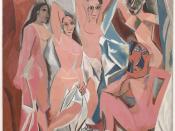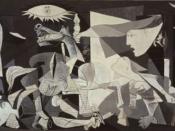Throughout time, there have been many famous works of art in painting, sculpture, and architecture. The painting Guernica, which was created in 1937 by Pablo Picasso, is still considered today to be one of the most famous works of art throughout the twentieth century.
Pablo Picasso is well known for colorful abstract paintings. His unique talent of creating a painting that may not look like real life, but has a deeper meaning, has been copied by many other modern painters. Picasso had many different styles of paintings during his life. Art historians have actually separated his life into different periods, which include the blue period, the rose period, cubism and his later works. Today, when I think about the works of Picasso, his works from his cubism period are more prevalent in my mind. Guernica happens to be one of these works.
Cubism emphasizes the flat, two-dimensional surface of the picture plane.
In cubism, you reject the traditional ideas of perspectives, foreshortening, and modeling. When an artist chooses to paint in the cubist style, he is not going for a natural look. Fragmented objects rather than natural looking objects depict cubist paintings.
When Picasso painted, he chose subjects that a viewer needed to look closely at to find the meaning. He also chose subjects that would tug at the viewer's heart. One such painting was Guernica. Guernica is modern art's most powerful antiwar statement. This famous painting, created within a three week time span in 1937, was inspired by a town named Guernica in northern Spain that was bombed by a fascist group led by Francisco Franco. The town, which was almost completely destroyed on April 26, 1937 during air raids, "burned for three days. Sixteen hundred civilians were killed or wounded."
On May 1, 1937, upon...


